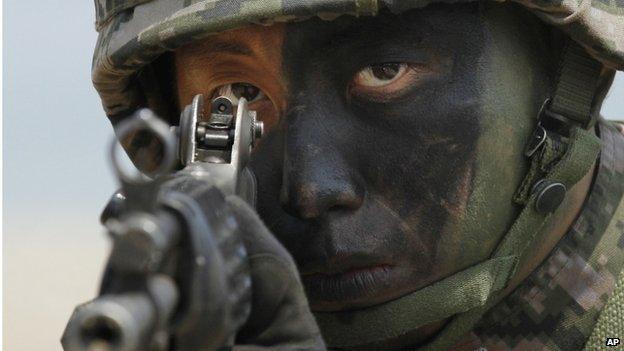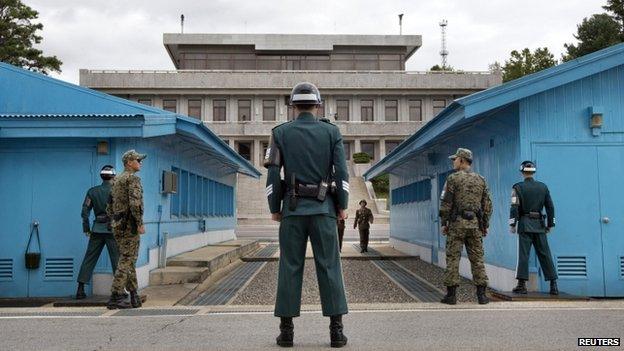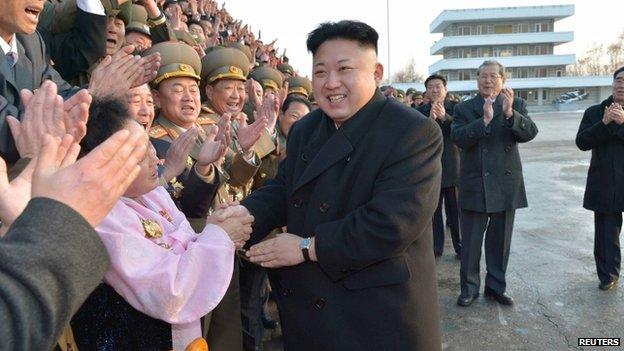Korea-watchers fear backlash from North over US drills
- Published

Seoul and Washington's yearly military drills near the Korean peninsula anger Pyongyang
The US and South Korea are set to begin another round of controversial military drills near the Korean peninsula. Such large-scale exercises have been held annually since 1976 to rehearse the alliance's plans for the defence of South Korea.
During February and March, exercise Key Resolve will focus on practising command and control procedures, while the overlapping Foal Eagle will deploy significant forces and military hardware for simulated combat in the field.
Neighbouring North Korea responds with hysteria when these exercises take place, often acting in ways which destabilise the region. In 2013, North Korea loudly threatened nuclear strikes on the United States and brought tensions on the peninsula to one of the highest points in recent memory.
As is often the case when dealing with pattern-prone Pyongyang, a repeat of this belligerence remains an unfortunate possibility despite the North and South's recent co-operation in briefly reuniting dozens of families separated by the Korean War.
'Vicious outbursts'

Tensions on the Korean peninsula escalated to a worrying degree in 2013
Washington and Seoul see joint military exercises like Key Resolve and Foal Eagle as performing several critical functions. The first is to prepare those countries' armed forces to defend the South in the event that a serious threat to its security arises. Wartime operational control of allied forces is slated to shift from the US to South Korea in 2015. This year's training therefore has increased importance in readying the South's forces for that transition.
The second function of regular joint drills is to assure South Korea that its alliance with the US remains strong, and Washington is prepared to come to its defence, whether with conventional or nuclear weapons.
Finally, the two countries see major military exercises as a means of deterring North Korean provocations through demonstrations of alliance capability and solidarity. Reflecting this thinking, impromptu joint exercises were announced after North Korea shelled Yeonpyeong Island in 2010.
North Korea cries foul. It claims that large-scale joint military exercises in and around the Korean peninsula are the guise under which the US and South Korea will prepare an invasion across the 38th parallel.
To demonstrate its anger, North Korea commonly draws on a toolbox of responses:
Threatening conventional or nuclear retaliation; raising the alert levels of its forces
Withdrawing from ongoing diplomatic initiatives
Declaring the Armistice Agreement invalid
Cutting off military hotlines
Deploying or testing military hardware such as missiles
And announcing its inability to guarantee the safety of foreign assets, including diplomatic staff.
In 2013 it did nearly all of the above, escalating the situation to a worrying degree.

North Korea may use the joint military exercises to justify pre-determined actions
Permanently detangling this potentially destabilising web of commitments and concerns around joint military exercises seems nigh on impossible.
All the while, Pyongyang's vicious outbursts continue to be met with confusion and concern from international audiences. Its apparently extreme reaction might be explained by a mixture of factors, each with varying salience depending upon the circumstance.
It is possible that at least some senior North Korean officials feel genuinely threatened by the appearance of sophisticated, often nuclear-capable military hardware in their backyard. However, even the most frightening film loses its edge after watching it on repeat for four decades.
'Crucial proposal'
On balance therefore, though a degree of genuine fear may appear in the background, propaganda and pretext may better explain North Korea's recent conniptions.
After decades of consistently circulating propaganda decrying joint exercises as evidence of US nuclear blackmail, comparative silence would be conspicuous. Pyongyang may wish to avoid appearing suddenly unthreatened.

The Koreas briefly co-operated in bringing dozens of families separated by the Korean war together
It may also wish to use regularly scheduled US-South Korean drills as a pretext for ostensibly unconnected decisions. In August 2013, North Korea abruptly announced the cancellation of US special envoy Ambassador Robert King's visit to Pyongyang, during which he was meant to secure the release of a detained American citizen. As justification, they cited the Ulchi Freedom Guardian drill, of which there was only hours remaining, as well as a B-52 practice sortie weeks before. This belated outburst stank of pretext.
Similar concerns that Pyongyang may use Key Resolve and Foal Eagle 2014 as convenient justification for pre-determined actions now exist.
In mid-January North Korea's National Defence Commission issued a "crucial proposal": cancel, move, or scale back joint drills, and in exchange North Korea will refrain from slandering and will consider facilitating reunions of families separated by the Korean War.
Family reunions have now fortunately moved forward. Yet so too have joint exercises. As a result, it is possible that when US military assets finally materialise in the region for Foal Eagle, North Korea could point to the overt rebuke of its goodwill, claim that it has no choice but to develop robust self-defences, and then subsequently revert to belligerence.
New nuclear or missile tests are some of the measures that North Korea may label as "proportional" responses to US-South Korean drills and the military assets deployed as part of them. North Korea reserves a special form of hatred for American nuclear-capable platforms, and frames many of its recent nuclear advancements as a direct reaction to their appearance near the Korean peninsula.
It may therefore be advisable for the US and South Korea to abstain from deploying such hardware as part of Foal Eagle 2014 and hope that the positive atmosphere fostered by family reunions will be sufficient to prevent a re-run of last year's tensions.
Andrea Berger is a research fellow in nuclear analysis at the Royal United Services Institute. Follow her on Twitter @AndreaRBerger.